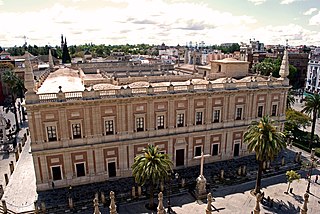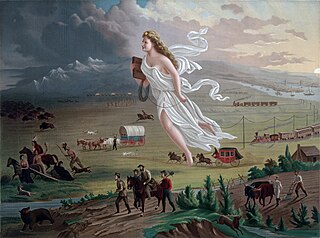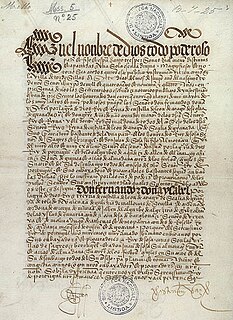 W
WHistory of North America encompasses the past developments of people populating the continent of North America. While it was widely believed that continent first became a human habitat when people migrated across the Bering Sea 40,000 to 17,000 years ago, recent discoveries may have pushed those estimates back at least another 90,000 years. People settled throughout the continent, from the Inuit of the far north to the Mayans and Aztecs of the south. These complex communities each developed their own unique ways of life and cultures.
 W
WThe history of the Caribbean reveals the significant role the region played in the colonial struggles of the European powers since the 15th century. In 1492, Christopher Columbus landed in the Caribbean and claimed the region for Spain. The following year, the first Spanish settlements were established in the Caribbean. Although the Spanish conquests of the Aztec empire and the Inca empire in the early sixteenth century made Mexico and Peru more desirable places for Spanish exploration and settlement, the Caribbean remained strategically important.
 W
WWhen studying the history of Central America one must first clarify just what Central America is. Today (2019) it is commonly taken to include Guatemala, Belize, El Salvador, Honduras, Nicaragua, Costa Rica, and Panama. This definition matches modern political borders. However, in some senses and at some times Central America begins in Mexico, at the Isthmus of Tehuantepec, and the former country of Yucatán was part of Central America. At the other end, before its independence in 1903 Panama was politically and culturally part of the South American country of Colombia, or its predecessors. At times English-speaking Belize, with a quite different history, has been considered as apart from Central America.
 W
WThe exploration of North America by non-indigenous people was a continuing effort to map and explore the continent and advance the economic interests of said non-indigenous peoples of North America. It spanned centuries, and consisted of efforts by numerous people and expeditions from various foreign countries to map the continent. See also the European colonization of the Americas
 W
WThe Age of Revolution is a period from the late 18th to the mid-19th centuries in which a number of significant revolutionary movements occurred in most of Europe and the Americas. The period is noted for the change from absolutist monarchies to representative governments with a written constitution, and the creation of nation states.
 W
WThe Amerrisque Mountains are the central spine of Nicaragua and part of the Central American Range which extends throughout central Nicaragua for about 700 km (430 mi) from Honduras in the northwest to Costa Rica in the southwest, just a few miles from the Caribbean. The Amerrisques also are known as Cordillera Chontaleña at their central range. Its coordinates are 12°12'0" N and 85°19'0" W in DMS or 12.2 and -85.3167 and is 329 meters above sea level.
 W
WThe Bracero program was a series of laws and diplomatic agreements, initiated on August 4, 1942, when the United States signed the Mexican Farm Labor Agreement with Mexico. For these farmworkers, the agreement guaranteed decent living conditions, and a minimum wage of 30 cents an hour, as well as protections from forced military service, and guaranteed part of wages were to be put into a private savings account in Mexico; it also allowed the importation of contract laborers from Guam as a temporary measure during the early phases of World War II.
 W
WA caudillo is a type of personalist leader wielding military and political power. There is no precise definition of caudillo, which is often used interchangeably with "warlord" and "strongman." The term is historically associated with Spain, and with Spanish America after virtually all of that region won independence in the early nineteenth century.
 W
WThe European colonization of the Americas describes the Age of Exploration and the resulting conquest and establishment of Western European control in what is now considered North and South America. Europe had been preoccupied with internal wars and was slowly recovering from the loss of population caused by the Black Death; thus the rapid rate at which it grew in wealth and power was unforeseeable in the early 15th century. European colonization impacted the political systems, geographic boundaries, and languages that predominate in the hemisphere's largely independent states today.
 W
WThe Archivo General de Indias, housed in the ancient merchants' exchange of Seville, Spain, the Casa Lonja de Mercaderes, is the repository of extremely valuable archival documents illustrating the history of the Spanish Empire in the Americas and the Philippines. The building itself, an unusually serene and Italianate example of Spanish Renaissance architecture, was designed by Juan de Herrera. This structure and its contents were registered in 1987 by UNESCO as a World Heritage Site together with the adjoining Seville Cathedral and the Alcázar of Seville.
 W
WAn Indigenous Peoples' History of the United States is a book written by the activist and historian Roxanne Dunbar-Ortiz and published by Beacon Press. It is the third of a series of five ReVisioning books which reconstruct and reinterpret U.S. history from marginalized peoples' perspectives. On July 23, 2019, the same press published An Indigenous Peoples' History of the United States for Young People, an adaptation by Jean Mendoza and Debbie Reese of Dunbar-Ortiz's original volume.
 W
WLoaded: A Disarming History of the Second Amendment is a book written by the historian Roxanne Dunbar-Ortiz and published by City Lights Books. It takes a close and unexpected look at the historical origins of the Second Amendment to the United States Constitution. Despite being no fan of guns, Dunbar approaches the subject from neither the liberal nor the conservative side of the usual debate, instead digging deeply into the subject as a historian to unearth surprising facts.
 W
WLubbock Lake Landmark, also known as Lubbock Lake Site, is an important archeological site and natural history preserve in the city of Lubbock, Texas. The preserve is 336 acres and is a protected state and federal landmark. There is evidence of ancient people and extinct animals at Lubbock Lake Landmark. It has evidence of nearly 12,000 years of use by ancient cultures on the Llano Estacado. It is run by the Museum of Texas Tech University.
 W
WManifest destiny was a widely held cultural belief in the 19th-century United States that American settlers were destined to expand across North America. There are three basic themes to manifest destiny:The special virtues of the American people and their institutions The mission of the United States to redeem and remake the west in the image of the agrarian East An irresistible destiny to accomplish this essential duty
 W
WThe Viceroyalty of New Spain was an integral territorial entity of the Spanish Empire, established by Habsburg Spain during the Spanish colonization of the Americas. It covered a huge area that included much of North America, northern parts of South America and several Pacific Ocean archipelagos, namely the Philippines and Guam. It originated in 1521 after the fall of Tenochtitlan, the main event of the Spanish conquest, and officially created on 18 August 1521 as a kingdom and later, the first of four viceroyalties Spain created in the Americas. Its first viceroy was Antonio de Mendoza y Pacheco, and the capital of the kingdom was Mexico City, established on the ancient Mēxihco-Tenōchtitlan.
 W
WThe North American fur trade, an aspect of the international fur trade, was the acquisition, trade, exchange, and sale of animal furs in North America. Aboriginal peoples and Native Americans of various regions of the present-day countries of Canada and the United States traded among themselves in the pre–Columbian Era. Europeans participated in the trade from the time of their arrival to Turtle Island, commonly referenced as the New World, extending the trade's reach to Europe. The French started trading in the 16th century, the English established trading posts on Hudson Bay in present-day Canada during the 17th century, while the Dutch had trade by the same time in New Netherland. The North American fur trade reached its peak of economic importance in the 19th century, and involved the development of elaborate trade-networks.
 W
WThe New World of the Western Hemisphere was devastated by the 1775–1782 North American smallpox epidemic. Columbus' first voyage to America can be attributed for bringing the smallpox virus to America and led to its spread across most of the continent of North America.
 W
WPaleo-Indians, Paleoindians or Paleo-Americans, were the first peoples who entered, and subsequently inhabited, the Americas during the final glacial episodes of the late Pleistocene period. The prefix "paleo-" comes from the Greek adjective palaios (παλαιός), meaning "old" or "ancient". The term "Paleo-Indians" applies specifically to the lithic period in the Western Hemisphere and is distinct from the term "Paleolithic".
 W
WPlymouth Rock is the traditional site of disembarkation of William Bradford and the Mayflower Pilgrims who founded Plymouth Colony in December 1620. The Pilgrims did not refer to Plymouth Rock in any of their writings; the first known written reference to the rock dates to 1715 when it was described in the town boundary records as "a great rock." The first documented claim that Plymouth Rock was the landing place of the Pilgrims was made by Elder Thomas Faunce in 1741, 121 years after the Pilgrims arrived in Plymouth.
 W
WHistory of North America encompasses the past developments of people populating the continent of North America. While it was widely believed that continent first became a human habitat when people migrated across the Bering Sea 40,000 to 17,000 years ago, recent discoveries may have pushed those estimates back at least another 90,000 years. People settled throughout the continent, from the Inuit of the far north to the Mayans and Aztecs of the south. These complex communities each developed their own unique ways of life and cultures.
 W
WHistory of North America encompasses the past developments of people populating the continent of North America. While it was widely believed that continent first became a human habitat when people migrated across the Bering Sea 40,000 to 17,000 years ago, recent discoveries may have pushed those estimates back at least another 90,000 years. People settled throughout the continent, from the Inuit of the far north to the Mayans and Aztecs of the south. These complex communities each developed their own unique ways of life and cultures.
 W
WBefore contact with Europeans, the natives of North America were divided into many different polities, from small bands of a few families to large empires. Modern anthropology assigns some larger divisions into various "culture areas", regions within which a particular set of cultural, political, subsistence and/or linguistic traits predominated. These pre-Columbian American culture areas may also roughly correspond to particular geographic and biological zones of the continent. During the thousands of years of native inhabitation on the continent, cultures changed and shifted. One of the oldest cultures yet found is that of the Clovis peoples. Upon the arrival of the Europeans in the "New World", Native American population declined substantially, primarily due to the introduction of European diseases to which the Native Americans lacked immunity.
 W
WThe 1763 Treaty of Paris ended the major war known by Americans as the French and Indian War and by Canadians as the Seven Years' War / Guerre de Sept Ans, or by French-Canadians, La Guerre de la Conquête. It was signed by Great Britain, France and Spain, with Portugal in agreement. Preferring to keep Guadeloupe, France gave up Canada and all of its claims to territory east of the Mississippi River to Britain. With France out of North America this dramatically changed the European political scene on the continent.
 W
WThe Treaty of Tordesillas, signed at Tordesillas in Spain on June 7, 1494, and authenticated at Setúbal, Portugal, divided the newly-discovered lands outside Europe between the Portuguese Empire and the Spanish Empire, along a meridian 370 leagues west of the Cape Verde islands, off the west coast of Africa. That line of demarcation was about halfway between the Cape Verde islands and the islands entered by Christopher Columbus on his first voyage, named in the treaty as Cipangu and Antilia.
 W
WVinland, Vineland or Winland was an area of coastal North America explored by Vikings. Leif Erikson first landed there around AD 1000, nearly five centuries before the voyages of Christopher Columbus and John Cabot. The name appears in the Vinland Sagas, and presumably describes both Newfoundland and the Gulf of Saint Lawrence as far as northeastern New Brunswick. Much of the geographical content of the sagas corresponds to present-day knowledge of transatlantic travel and North America.
 W
WWestern civilization traces its roots back to Europe and the Mediterranean. It is linked to ancient Greece, the Roman Empire and with Medieval Western Christendom which emerged from the Middle Ages to experience such transformative episodes as the Renaissance, the Reformation, the Enlightenment, the Industrial Revolution, scientific revolution, and the development of liberal democracy. The civilizations of Classical Greece and Ancient Rome are considered seminal periods in Western history; a few cultural contributions also emerged from the pagan peoples of pre-Christian Europe, such as the Celts and Germans, as well as some significant religious contributions derived from Judaism and Hellenistic Judaism stemming back to Second Temple Judea, Galilee, and the early Jewish diaspora; and some other Middle Eastern influences. Western Christianity has played a prominent role in the shaping of Western civilization, which throughout most of its history, has been nearly equivalent to Christian culture.. Western civilization has spread to produce the dominant cultures of modern Americas and Oceania, and has had immense global influence in recent centuries in many ways.
 W
WThe swastika is an ancient Indo-European religious symbol with the earliest known example found in Mezine, modern Ukraine, that generally takes the form of an equilateral cross with four legs each bent at 90 degrees in either right-facing (卐) form or its mirrored left-facing (卍) form. It is considered to be a sacred and auspicious symbol in Hinduism, Buddhism, and Jainism and dates back at least 11,000 years.